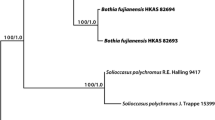Abstract
Phyllosticta styracicola sp. nov. on Styrax grandiflorus from Xishuangbanna Tropical Botanical Garden, Yunnan province, China, and Phyllosticta hubeiensis sp. nov. on Viburnum odoratissimum from Shennongjia forest, Hubei province, China, are described and illustrated in this paper. Phylogenetic analysis based on nrDNA-internal transcribed spacer (ITS) and a combined multi-locus alignment of the ITS, partial translation elongation factor 1-alpha (TEF1), actin (ACT) and glyceraldehydes-3-phosphate dehydrogenase (GAPDH) gene regions indicated that these two species were closely related to P. ampelicida and P. gaultheriae respectively. Justifications of the novelties of both species are provided.




Similar content being viewed by others
References
Baayen R, Bonants P, Verkley G, Carroll G, Van der Aa H, De Weerdt M, Van Brouwershaven I, Schutte G, Maccheroni W Jr, de Blanco CG (2002) Nonpathogenic isolates of the citrus black spot fungus, Guignardia citricarpa, identified as a cosmopolitan endophyte of woody plants, G. mangiferae (Phyllosticta capitalensis). Phytopathology 92:464–477
Carbone I, Kohn LM (1999) A method for designing primer sets for speciation studies in filamentous ascomycetes. Mycologia 91:553–556
Choi YW, Hyde KD, Ho W (1999) Single spore isolation of fungi. Fungal Divers 3:29–38
Donoghue MJ, Eriksson T, Reeves PA, Olmstead RG (2001) Phylogeny and phylogenetic taxonomy of Dipsacales, with special reference to Sinadoxa and Tetradoxa (Adoxaceae). Harv Paper Bot 6:459–480
Farr DF, Rossman AY. Fungal Databases, Systematic Mycology and Microbiology Laboratory, ARS, USDA. Retrieved September 9, 2012, from http://nt.ars-grin.gov/fungaldatabases/
Glienke C, Pereira O, Stringari D, Fabris J, Kava-Cordeiro V, Galli-Terasawa L, Cunnington J, Shivas R, Groenewald J, Crous P (2011) Endophytic and pathogenic Phyllosticta species, with reference to those associated with Citrus Black Spot. Persoonia Mol Phylogeny Evol Fungi 26:47–56
Guerber JC, Liu B, Correll JC, Johnston PR (2003) Characterization of diversity in Colletotrichum acutatum sensu lato by sequence analysis of two gene introns, mtDNA and intron RFLPs, and mating compatibility. Mycologia 95:872
Hall TA (1999) BioEdit: a user-friendly biological sequence alignment editor and analysis program for Windows 95/98/NT. Nucleic Acids Symp Ser 41:95–98
Hudson H (1987) Guignardia leaf blotch of horsechestnut. Trans Br Mycol Soc 89:400–401
Jin J (2011) Conidial morphology changes in four Phyllosticta species. Mycotaxon 115:401–406
Katoh K, Toh H (2010) Parallelization of the MAFFT multiple sequence alignment program. Bioinformatics 26(15):1899–1900
Miura M (1957) Fungus flora deposited in the phytopathological laboratory of Akita Prefecture Agricultural Experiment Station. Rep Akita Pref Agric Exp Stn 8:1–64
Motohashi K, Araki I, Nakashima C (2008) Four new species of Phyllosticta, one new species of Pseudocercospora, and one new combination in Passalora from Japan. Mycoscience 49:138–146
Motohashi K, Inaba S, Anzai K, Takamatsu S, Nakashima C (2009) Phylogenetic analyses of Japanese species of Phyllosticta sensu stricto. Mycoscience 50:291–302
Myllys L, Stenroos S, Thell A (2002) New genes for phylogenetic studies of lichenized fungi: glyceraldehyde-3-phosphate dehydrogenase and beta-tubulin genes. Lichenologist 34:237–246
Nylander JAA (2004) MrModeltest v2. Program distributed by the author. Evolutionary Biology Centre, Uppsala University
Okane I, Nakagiri A, Ito T (2001) Identity of Guignardia sp. inhabiting ericaceous plants. Can J Bot 7:101–109
Okane I, Lumyong S, Nakagiri A, Ito T (2003) Extensive host range of an endophytic fungus, Guignardia endophyllicola (anamorph: Phyllosticta capitalensis). Mycoscience 44:353–363
Rayner RW (1970) A mycological colour chart. British Mycological Society
Rogers SO, Benedich AJ (1994) Extraction of total cellular DNA from plants, algae and fungi. In: Gelvin SB, Schilerpoort RA (eds) Plant molecular biology manual, 2nd edn. Kluwer Academic Publishers, Dordrecht, pp 1–8
Schoch CL, Seifert KA, Huhndorf S, Robert V, Spougea JL, Levesqueb CA, Chen W, Fungal Barcoding Consortiuma (2012) Nuclear ribosomal internal transcribed spacer (ITS) region as a universal DNA barcode marker for Fungi. Proc Natl Acad Sci USA. doi:10.1073/pnas.1117018109
Shivas RG, Cai L (2012) Cryptic fungal species unmasked. Microbiology Australia 33:36–37
Silva M, Pereira O, Braga I, Lelis S (2008) Leaf and pseudobulb diseases on Bifrenaria harrisoniae (Orchidaceae) caused by Phyllosticta capitalensis in Brazil. Australas Plant Dis Notes 3:53–56
Su YY, Cai L (2012) Polyphasic characterization of three new Phyllosticta spp. Persoonia 28:76–84
Swofford DL (2003) PAUP*: phylogenetic analysis using parsimony, version 4.0 b10. Sinauer, Sunderland
van der Aa HA (1973) Studies in Phyllosticta. Stud Mycol 5:1–110
van der Aa HA, Vanev S (2002) A revision of the species described in Phyllosticta. Centraalbureau voor Schimmelcultures, Utrecht
Wang X, Chen G, Huang F, Zhang J, Hyde KD, Li H (2011) Phyllosticta species associated with citrus diseases in China. Fungal Divers 52:1–16
White T, Bruns T, Lee S, Taylor J (1990) Amplification and direct sequencing of fungal ribosomal RNA genes for phylogenetics. PCR protocols A guide to methods and applications. Academic Press, pp 315–322
Wikee S, Udayanga D, Crous PW, Chukeatirote E, McKenzie EHC, Bahkali AH, Dai DQ, Hyde KD (2011) Phyllosticta—an overview of current status of species recognition. Fungal Divers 51:1–19
Wulandari N, To-Anun C, Hyde K, Duong L, De Gruyter J, Meffert J, Groenewald J, Crous P (2009) Phyllosticta citriasiana sp. nov., the cause of Citrus tan spot of Citrus maxima in Asia. Fungal Divers 34:23–39
Wulandari N, To-anun C, Cai L, Abd-Elsalam KA, Hyde KD (2010) Guignardia/Phyllosticta species on banana. Cryptogamie. Mycologie 31:403–418
Wulandari N, To-Anun C, McKenzie E, Hyde K (2011) Guignardia bispora and G. ellipsoidea spp. nov. and other Guignardia species from palms (Arecaceae). Mycosphere 2:115–128
Acknowledgments
This work was financially funded by CASKSCX2-YW-Z-1026 and NSFC (National Natural Science Foundation of China) 31110103906. Ms. Fang Liu is thanked for technical assistance.
Author information
Authors and Affiliations
Corresponding author
Rights and permissions
About this article
Cite this article
Zhang, K., Su, YY. & Cai, L. Morphological and phylogenetic characterisation of two new species of Phyllosticta from China. Mycol Progress 12, 547–556 (2013). https://doi.org/10.1007/s11557-012-0861-7
Received:
Revised:
Accepted:
Published:
Issue Date:
DOI: https://doi.org/10.1007/s11557-012-0861-7




